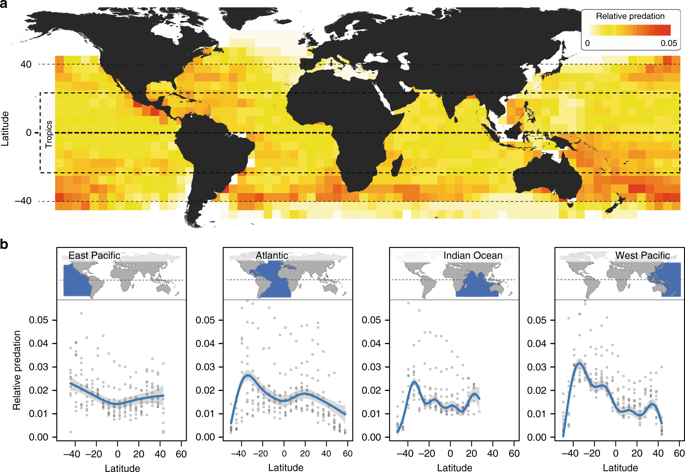Nature Communications ( IF 14.7 ) Pub Date : 2020-03-31 , DOI: 10.1038/s41467-020-15335-4 Marius Roesti 1, 2, 3 , Daniel N Anstett 1, 4 , Benjamin G Freeman 1, 2 , Julie A Lee-Yaw 1, 4, 5 , Dolph Schluter 1, 2 , Louise Chavarie 1, 2, 6 , Jonathan Rolland 1, 2, 7 , Roi Holzman 1, 2, 8, 9

|
Species interactions are widely thought to be strongest in the tropics, potentially contributing to the greater number of species at lower latitudes. Yet, empirical tests of this “biotic interactions” hypothesis remain limited and often provide mixed results. Here, we analyze 55 years of catch per unit effort data from pelagic longline fisheries to estimate the strength of predation exerted by large predatory fish in the world’s oceans. We test two central tenets of the biotic interactions hypothesis: that predation is (1) strongest near the equator, and (2) positively correlated with species richness. Counter to these predictions, we find that predation is (1) strongest in or near the temperate zone and (2) negatively correlated with oceanic fish species richness. These patterns suggest that, at least for pelagic fish predation, common assumptions about the latitudinal distribution of species interactions do not apply, thereby challenging a leading explanation for the latitudinal gradient in species diversity.
中文翻译:

温带地区的中上层鱼类捕食能力强于赤道附近。
人们普遍认为热带地区的物种相互作用最强,这可能导致低纬度地区物种数量增加。然而,对这种“生物相互作用”假说的实证检验仍然有限,并且经常提供好坏参半的结果。在这里,我们分析了来自中上层延绳钓渔业 55 年单位努力捕获量的数据,以估计世界海洋中大型掠食性鱼类的捕食强度。我们测试了生物相互作用假说的两个中心原则:捕食(1)赤道附近最强,(2)与物种丰富度呈正相关。与这些预测相反,我们发现捕食(1)在温带或温带附近最强,(2)与海洋鱼类物种丰富度负相关。这些模式表明,至少对于中上层鱼类捕食而言,关于物种相互作用纬度分布的常见假设并不适用,从而挑战了对物种多样性纬度梯度的主要解释。











































 京公网安备 11010802027423号
京公网安备 11010802027423号